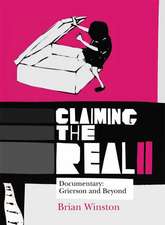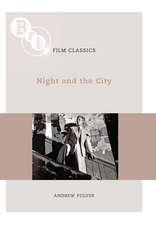Shadows: BFI Film Classics
Autor Raymond Carneyen Limba Engleză Paperback – mai 2001
Din seria BFI Film Classics
-
 Preț: 81.11 lei
Preț: 81.11 lei -
 Preț: 74.79 lei
Preț: 74.79 lei - 39%
 Preț: 60.76 lei
Preț: 60.76 lei - 39%
 Preț: 60.85 lei
Preț: 60.85 lei - 39%
 Preț: 61.30 lei
Preț: 61.30 lei - 39%
 Preț: 60.85 lei
Preț: 60.85 lei - 39%
 Preț: 60.85 lei
Preț: 60.85 lei - 39%
 Preț: 61.30 lei
Preț: 61.30 lei - 40%
 Preț: 60.42 lei
Preț: 60.42 lei - 40%
 Preț: 60.42 lei
Preț: 60.42 lei - 39%
 Preț: 61.29 lei
Preț: 61.29 lei - 39%
 Preț: 60.85 lei
Preț: 60.85 lei - 39%
 Preț: 60.85 lei
Preț: 60.85 lei - 39%
 Preț: 61.30 lei
Preț: 61.30 lei - 40%
 Preț: 60.42 lei
Preț: 60.42 lei - 40%
 Preț: 59.69 lei
Preț: 59.69 lei - 37%
 Preț: 64.42 lei
Preț: 64.42 lei - 39%
 Preț: 60.85 lei
Preț: 60.85 lei - 40%
 Preț: 59.62 lei
Preț: 59.62 lei - 40%
 Preț: 60.50 lei
Preț: 60.50 lei - 39%
 Preț: 60.85 lei
Preț: 60.85 lei - 39%
 Preț: 60.85 lei
Preț: 60.85 lei - 39%
 Preț: 60.85 lei
Preț: 60.85 lei -
 Preț: 121.34 lei
Preț: 121.34 lei - 39%
 Preț: 61.76 lei
Preț: 61.76 lei - 39%
 Preț: 60.85 lei
Preț: 60.85 lei - 39%
 Preț: 60.85 lei
Preț: 60.85 lei -
 Preț: 100.10 lei
Preț: 100.10 lei - 39%
 Preț: 60.85 lei
Preț: 60.85 lei - 39%
 Preț: 61.04 lei
Preț: 61.04 lei - 39%
 Preț: 60.76 lei
Preț: 60.76 lei - 39%
 Preț: 60.85 lei
Preț: 60.85 lei - 39%
 Preț: 61.23 lei
Preț: 61.23 lei - 39%
 Preț: 61.76 lei
Preț: 61.76 lei - 40%
 Preț: 59.62 lei
Preț: 59.62 lei - 39%
 Preț: 60.85 lei
Preț: 60.85 lei - 40%
 Preț: 60.42 lei
Preț: 60.42 lei - 40%
 Preț: 60.48 lei
Preț: 60.48 lei - 37%
 Preț: 64.42 lei
Preț: 64.42 lei - 39%
 Preț: 60.85 lei
Preț: 60.85 lei - 39%
 Preț: 61.57 lei
Preț: 61.57 lei - 39%
 Preț: 61.57 lei
Preț: 61.57 lei - 40%
 Preț: 60.42 lei
Preț: 60.42 lei - 39%
 Preț: 60.85 lei
Preț: 60.85 lei - 39%
 Preț: 60.95 lei
Preț: 60.95 lei - 39%
 Preț: 61.76 lei
Preț: 61.76 lei - 39%
 Preț: 60.85 lei
Preț: 60.85 lei - 40%
 Preț: 60.60 lei
Preț: 60.60 lei - 39%
 Preț: 61.76 lei
Preț: 61.76 lei
Preț: 60.67 lei
Nou
Puncte Express: 91
Preț estimativ în valută:
11.61€ • 12.19$ • 9.64£
11.61€ • 12.19$ • 9.64£
Carte disponibilă
Livrare economică 21 martie-04 aprilie
Preluare comenzi: 021 569.72.76
Specificații
ISBN-13: 9780851708355
ISBN-10: 0851708358
Pagini: 87
Ilustrații: illustrations
Dimensiuni: 135 x 190 x 8 mm
Greutate: 0.17 kg
Ediția:2001
Editura: British Film Institute
Colecția British Film Institute
Seria BFI Film Classics
Locul publicării:London, United Kingdom
ISBN-10: 0851708358
Pagini: 87
Ilustrații: illustrations
Dimensiuni: 135 x 190 x 8 mm
Greutate: 0.17 kg
Ediția:2001
Editura: British Film Institute
Colecția British Film Institute
Seria BFI Film Classics
Locul publicării:London, United Kingdom
Textul de pe ultima copertă
John
Cassavetes'
"Shadows"
is
generally
regarded
as
the
start
of
the
independent
feature
movement
in
America.
Made
for
$40,000
with
a
nonprofessional
cast
and
crew
and
borrowed
equipment,
the
film
caused
a
sensation
on
its
London
release
in
1960.
The
film
traces
the
lives
of
three
siblings
in
an
African-American
family:
Hugh,
a
struggling
jazz
singer,
attempting
to
obtain
a
job
and
hold
onto
his
dignity;
Ben,
a
Beat
drifter
who
goes
from
one
fight
and
girlfriend
to
another;
and
Lelia,
who
has
a
brief
love
affair
with
a
white
boy
who
turns
on
her
when
he
discovers
her
race.
In
a
delicate,
semi-comic
drama
of
self-discovery,
the
main
characters
are
forced
to
explore
who
they
are
and
what
really
matters
in
their
lives.
"Shadows"
ends
with
the
title
card
'The
film
you
have
just
seen
was
an
improvisation,'
and
for
decades
was
hailed
as
a
masterpiece
of
spontaneity,
but
shortly
before
Cassavetes'
death,
he
confessed
to
Ray
Carney
something
he
had
never
before
revealed
-
that
much
of
the
film
was
scripted.
He
told
him
that
it
was
shot
twice
and
that
the
scenes
in
the
second
version
were
written
by
him
and
Robert
Alan
Aurthur,
a
professional
Hollywood
screenwriter.
For
Carney,
it
was
Cassavetes'
Rosebud.
He
spent
ten
years
tracking
down
the
surviving
members
of
the
cast
and
crew,
and
piecing
together
the
true
story
of
the
making
of
the
film.
Carney
takes
the
reader
behind
the
scenes
to
follow
every
step
in
the
making
of
the
movie
-
chronicling
the
hopes
and
dreams,
the
struggles
and
frustrations,
and
the
ultimate
triumph
of
the
collaboration
that
resulted
in
one
of
the
seminal
masterworks
of
American
independent
filmmaking.
Highlights
of
the
presentation
are
more
than
30illustrations
(including
the
only
existing
photographs
of
the
dramatic
workshop
Cassavetes
ran
in
the
late
fifties
and
of
the
stage
on
which
much
of
"Shadows"
was
shot,
and
a
still
showing
a
scene
from
the
'lost'
first
version
of
the
film);
and
statements
by
many
of
the
film's
actors
and
crew
members
detailing
previously
unknown
events
during
its
creation.
One
of
the
most
interesting
and
original
aspects
of
the
book
is
an
nine-page
Appendix
that
'reconstructs'
much
of
the
lost
first
version
of
the
film
for
the
first
time.
The
Appendix
points
out
more
than
100
previously
unrecognized
differences
between
the
1957
and
1959
shoots,
all
of
which
are
identified
in
detail
both
by
the
scene
and
the
time
at
which
they
occur
in
the
current
print
of
the
movie
(so
that
they
may
be
easily
located
on
videotape
or
DVD
by
anyone
viewing
the
film).
By
comparing
the
two
versions,
the
Appendix
allows
the
reader
to
eavesdrop
on
Cassavetes'
process
of
revision
and
watch
his
mind
at
work
as
he
re-thought,
re-shot,
re-edited
his
movie.
None
of
this
information,
which
Carney
spent
more
than
five
years
compiling,
has
ever
appeared
in
print
before
(and,
as
the
presentation
reveals,
the
few
studies
that
have
attempted
to
deal
with
this
issue
prior
to
this
are
proved
to
have
been
completely
mistaken
in
their
assumptions).
The
comparison
of
the
versions
and
the
treatment
of
Cassavetes'
revisionary
process
is
definitive
and
final,
for
all
time.












